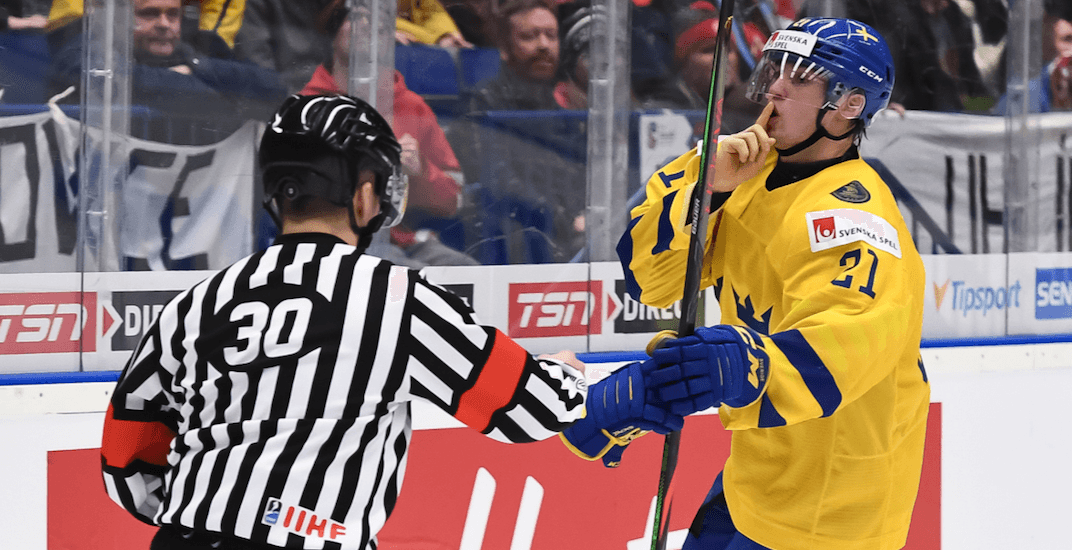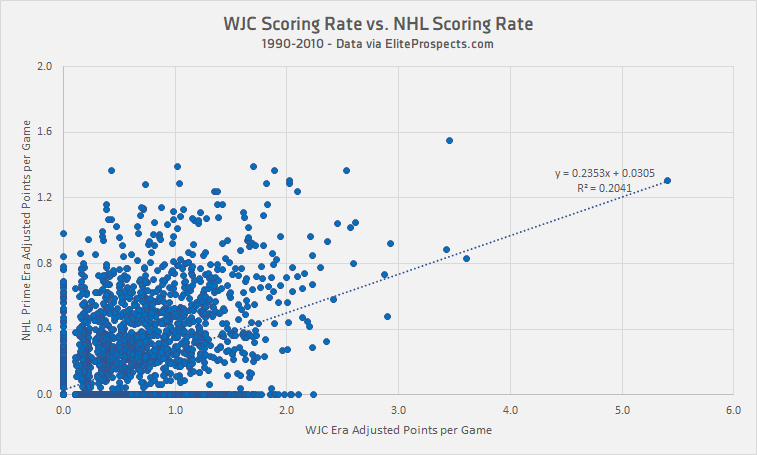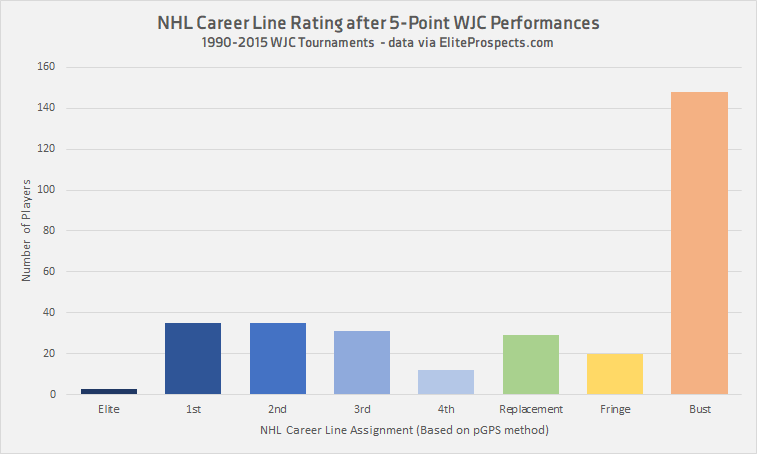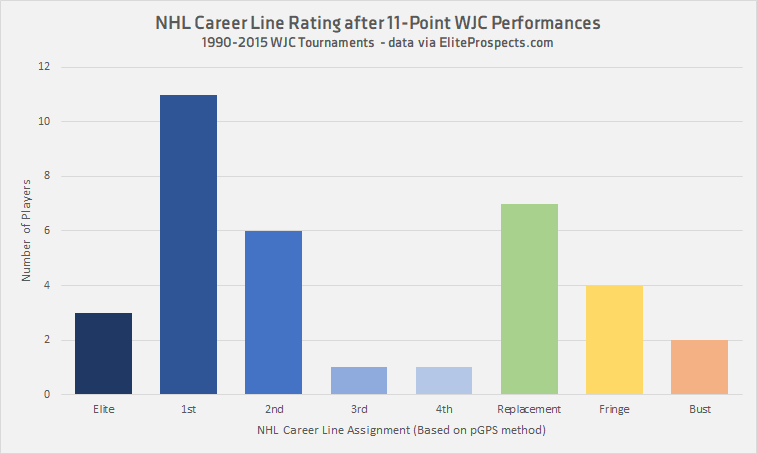How Important is it to Produce at the World Junior Championship?

By Jeremy Davis
4 years agoAnother World Junior Championship has come and gone, this time with Canada getting back on top and winning gold. For Canadians from coast to coast, that’s something to feel good about. For NHL fans, watching their teams’ prospects on the big stage is nearly as exciting as watching your home country succeed.
Here in Vancouver, we were keeping a close eye on the four Canucks prospects at the tournament, and while tabs were kept on Finland’s Toni Utunen and Karel Plasek of the Czech Republic, the real draws were Nils Hoglander and Vasili Podkolzin. The two were Vancouver’s second and first round picks, respectively, at the 2019 NHL Entry Draft in June, and they carry a lot of expectation with them. Canucks fans have already begun penciling them into the NHL team’s top six a couple of years down the road, and who could blame them?
Stylistically, they couldn’t be much more different, but there was another major difference at the World Juniors: their production. Hoglander lit up the scoresheet, accumulating 11 points in his seven games (which placed him third in the entire tournament), and graced many a highlight reel to boot.
Failed to load video.
Podkolzin, on the other hand, was relatively quiet on the scoresheet, picking up a goal and four assists in seven games (en route to a silver medal), though he dazzled with his physical presence and puck possession. As our own Brett Lee detailed in his recent article on Podkolzin, the Russian winger probably deserved a few extra assists too, if his teammates had been able to convert on some grade A scoring chances set up by the Canucks prospect.
(Lee’s piece on Hoglander’s playmaking shouldn’t go without being noted here either, it’s excellent.)
Imagining how many points a player deserves to have accumulated can be a misleading and fruitless exercise however – the numbers are what they are. Here’s the question then: how important is it to produce at the World Juniors?
Typically, the answer that we’d be provided with would be a matter of perspective. When a player puts up big numbers (like Hoglander did), World Junior scoring is seen as a sign of great things to come. When a prospect puts up relatively mediocre numbers… well then the numbers aren’t as important as how the player looked.
To get a more straightforward answer though, I’ll dig into the numbers to see what the various levels of production mean for a prospect’s future in the NHL.
The Relationship Between WJC Scoring and NHL Scoring
An analysis of World Junior Championship scoring data from 1990 to 2010, culled from EliteProspects.com, reveals that there is indeed a clear positive relationship between WJC scoring and eventual NHL production.

The correlation is roughly on par with what we see in many other leagues, such as North American major junior and European professional leagues. The bigger issue with World Junior scoring rates is the inherently small sample sizes – I’ve included players with a minimum of five games played in the sample used above, but the maximum is only eight games. That allows for large swings in scoring rates on a game-to-game basis, made even more pronounced by the huge difference competition between some of the more dominant nations and those trying to stave off relegation to Division I.
All this means that even though more production is a good thing, we still have less confidence in the stability of that production than we would in domestic leagues over long seasons.
Podkolzin is the ninth Canucks drafted prospect to score five points at the event, with his predecessors including the likes of Mattias Ohlund (1996), Artem Chubarov (1998), Daniel Sedin (1998), R.J. Umberger (2002) and Sergei Shirokov (2006). Age makes a big difference here; Daniel Sedin was a year younger when he put up those numbers, while many of the other prospect were a year older.

While the number of “busts” (defined as players that went on to play zero NHL games) might be disconcerting, there are a number of extenuating circumstances. For one, a significant portion of this 148-player sample were undrafted players, or they played for less dominant nations like Kazakhstan, Norway, Ukraine or Austria. This is important for a couple of reasons: for one, opportunity offered during the development process plays a huge role. A drafted player has tremendous advantages over an undrafted player who is otherwise similar. Regarding nationality, merely being selected to play for one of the powerhouse nations like Canada, Sweden or Russia bodes well for a player’s future as a professional, while cracking the squad of one of the minnows means a fair bit less.
As for the rest of the sample, the elite players that had 5-point tournaments include Sidney Crosby and Evgeni Malkin, with first liners including John Tavares, Jack Eichel and Vladimir Tarasenko. The issue with comparing Podkolzin’s output to a lot of these players is their ages – many were 16 or 17 when they put up similar numbers. If we cut the sample down to draft-plus-one seasons only, we’d still see encouraging names like Artemi Panarin, Filip Forsberg and Henrik Zetterberg (as well as a wide variety of lesser-knowns and nobodies).
Hoglander, meanwhile, is the second Canucks prospect to collect 11 points at the tournament, following Jordan Schroeder (remember him?), who had three goals and eight assists in six points for Team USA in 2009. Only three Canucks prospects have topped 11 points in the tournaments: Henrik Sedin had 13 points at the 2000 tournament, Pavel Bure had 15 points in 1991, and Cody Hodgson leads the pack with 16 points in 2009.
35 players scored 11 points at World Junior tournaments between 1990 and 2015, and they went on to forge a wide variety of careers. Using the line assignment system from my pGPS model, that subsection of prospects produced three elite players (including Peter Forsberg, Alex Ovechkin and Connor McDavid, who scored 11 points in 1992, 2005 and 2015 respectively), 11 First Line forwards (including Zach Parise, Phil Kessel, Vladimir Tarasenko and Evgeni Kuznetsov), six Second Line forwards and seven Replacement Level forwards (including the aforementioned Schroeder), among a smattering of other results.

So what can we glean from their scoring at this year’s tournament? Realistically, not a whole lot. We already have much larger, much more reliable samples available for both players in high end European professional leagues (moreso Hoglander in the Swedish league, if we’re being honest; Podkolzin’s deployment continues to cast a fog on his numbers). Because of the small samples at the tournament, we have some positive signs, but nothing too weighty or definitive.
Based on the historical sample though, I’d be comfortable with the following conclusion: scoring a lot of points is a sign of good things to come, but failing to score a lot of points doesn’t condemn a prospect. From that point of view, Hoglander’s performance is great news and while Podkolzin’s middling numbers aren’t a clear positive, they can more or less be swept under the rug. That’s alright considering that although they had the same draft eligibility, Hoglander actually has a leg up developmental years, being born in December. As such, Hoglander’s World Junior career is at an end, while Podkolzin’s June birthday will allow him to take another crack at the tournament next season, and maybe leave a point total that’s just as impressive as he is visually.
Recent articles from Jeremy Davis





